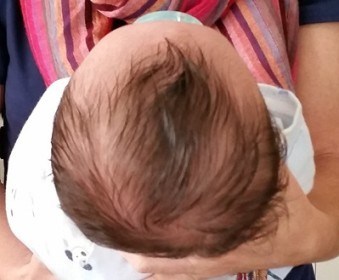If you’re concerned that your baby may have flat head syndrome, you’re not alone. Flat head syndrome, or plagiocephaly, is very common, especially since more babies than ever are being put to bed on their backs to prevent SIDS. While this practice has proven effective, drastically reducing crib death, it has resulted in a higher occurrence of flat head syndrome. So how can you tell if your baby has flat head syndrome? Here are things to know and signs to look for:
-
Be aware that flat head syndrome can be subjective. Some people notice every little bump on a baby’s head, while others have a harder time noticing a change in head shape. The best and most objective way to monitor your baby’s head is by taking pictures. Take them from all angles and really look at them. Retake the photos in a week and see if it has gotten better or worse. Our eyes can play tricks on us so photographs will help a lot. While severe flat head syndrome is obvious, there is certainly a good deal of gray area.
-
Look to see if the ears are aligned. If the ears are not aligned, this typically indicates a moderately severe case of plagiocephaly. In such a case, you can probably also see some volume difference in the cheeks, and the forehead may be flatter on one side.
-
Look for flattening on the back of the head. For babies who sleep on their back with their head straight up, flattening in the center back of the head can occur. This is called ‘brachycephaly’. You can look from the top of your baby’s head, and sometimes a side view is helpful. There should be fullness or rounding in the back of the head. Brachycephaly is treated the same as plagiocephaly and should be addressed as soon as possible.
-
Be aware that there’s a new normal. Expectations of head shapes and ratios have changed because of the shift from babies sleeping on their stomachs to their backs. Our babies now have wider heads than those of us who slept on our stomachs. Regardless of how common it is, though, you should certainly ask your pediatrician about it if your baby’s head shape concerns you.
-
Intervene early to prevent plagiocephaly. If you notice that your baby is developing flat head syndrome, begin taking steps to correct it as soon as possible. Plagiocephaly is preventable in the first four to five months of life, so talk to your doctor and get some assistance as soon as possible.
Both plagiocephaly and torticollis, or tight neck, can be prevented or corrected through simple actions, like repositioning or therapy. At Baby Begin, we have the tools and resources to help your baby grow and thrive, free from stiff neck muscles and flat head syndrome. For more information, please visit our website, or connect with our online community on Facebook, Twitter and LinkedIn.

